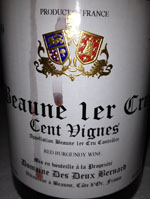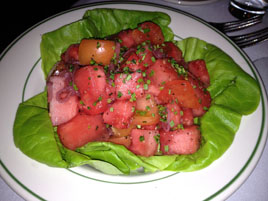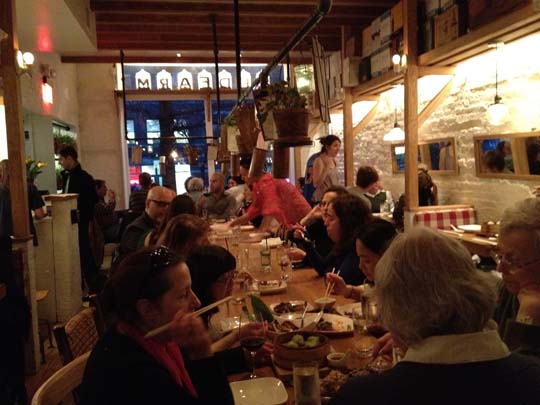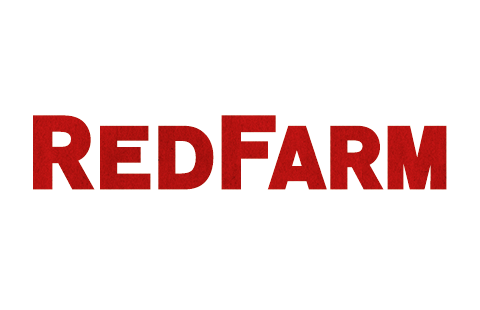The Marrow
 Monday, January 28, 2013 at 06:04PM
Monday, January 28, 2013 at 06:04PM Note: The Marrow closed in October 2014 after two years in business. Reviews were mixed, and the public never fell in love with the restaurant’s bifurcated Italian/German concept.
*
 Either Harold Dieterle is an ace restaurateur, or he has some terrific advisers. The former Top Chef winner now has three NYC restaurants, and by my reckoning they’re all hits, which seems to be the public verdict, as well. That kind of success doesn’t happen by accident.
Either Harold Dieterle is an ace restaurateur, or he has some terrific advisers. The former Top Chef winner now has three NYC restaurants, and by my reckoning they’re all hits, which seems to be the public verdict, as well. That kind of success doesn’t happen by accident.
Welcome to The Marrow, which opened in late December, joining a brood that now includes Perilla (opened 2007) and Kin Shop (2010).
Admittedly, he’s not aiming high at any of these places: they straddle the line between neighborhood spots and minor destinations. They’re all basically casual, two-star places when they’re on their game.
 You’ve got to give the guy credit for taking some risks. After the generic, New American Perilla, he opened a Thai restaurant, of all things, at Kin Shop. It could easily have flopped, but didn’t.
You’ve got to give the guy credit for taking some risks. After the generic, New American Perilla, he opened a Thai restaurant, of all things, at Kin Shop. It could easily have flopped, but didn’t.
At The Marrow, there’s a bifurcated menu, with German dishes on the right and Italian ones on the left, reflecting the chef’s family heritage. (The menu is actually laid out like a family tree, which sounds more gimmicky than it is.) There’s no perceptible market demand for this odd combination, so you’ve got to assume that Dieterle is serving what he actually believes in.
The tightly edited menu offers six charcuterie options ($6–14), eight starters ($12–15), eight mains ($23–33) and four sides ($10–14), in each case split half-and-half between the German and Italian sides of a single sheet of paper. Some of the prices are a bit aggressive, including all of the sides and a $26 mushroom entrée. Main course portions are quite ample, and most seem to come with vegetables anyway, so I am not sure why you would even need those sides.
 If we’re nitpicking, it must be noted that some of the assignments to the German or Italian side seem arbitrary. The chicken entrée is (supposedly) Italian, but Dieterle’s preparation of it—admittedly excellent—is generic enough to fit almost any menu in town.
If we’re nitpicking, it must be noted that some of the assignments to the German or Italian side seem arbitrary. The chicken entrée is (supposedly) Italian, but Dieterle’s preparation of it—admittedly excellent—is generic enough to fit almost any menu in town.
The wine list isn’t online, which is a shame. It’s one of the deeper wine lists I’ve seen at a new, casual restaurant. You can do real (financial) damage here, or order the Fabrizio Iuli ($49; above left), as we did, and be very happy. A sommelier comes promptly to the table, knows the list well, and presents a bottle that has been kept at the proper temperature.
In relation to the price of the restaurant, the $12 cocktails could be considered a bargain. We can endorse the Marrow 75 (bitter truth pink gin, lemon, sage, blanc de blancs) and the Bank Robber (bulleit bourbon, punt e mes, Campari).


You’ll guess that Liverwurst ($10; above left) came from the German side of the menu. But how about the signature Bone Marrow, a trench of bone topped off with sea urchin, fried potatoes, meyer lemon aioli, and baby celery greens? It comes from the Italian side, though I’ve not seen it anywhere, and I doubt that Grandma Chiarelli served it at home either. But it’s terrific: surely a must-order. I’ll bet he sends out hundreds of them every week.


I’d skip the Duck Schnitzel ($29; above left), which was too dry. It needs more of the stewed wolfberries (upper left in the photo), to contrast with the bland, pan-fried duck. The quark spaetzle, hazelnuts, and cucumber-potato salad aren’t memorable either. But the aforementioned chicken ($24; above right) is a winner. The bird itself is beautifully done; hiding underneath is a warm medley of fennel, fried salami, and Brussels sprouts.
The service was attentive and professional. I thought we might have been recognized, as initially a host told us we could not be seated before our appointed time (though there clearly were many empty tables) at 7:00 pm), but then another host overruled her, and decided we could. The bar was packed, and by the time we finished up, 90 minutes later, so was the (fairly small) dining room.
The menu is evolving: the version on the website is not exactly what we had, and there were also a number of announced specials. Although there was one dud (the Duck Schnitzel), this is a restaurant well worth returning to.
The Marrow (99 Bank Street at Greenwich Street, West Village)
Food: Half Italian, Half German, very liberally interpreted
Service: Very good, especially for such a new place
Ambiance: Upscale West Village Casual
Rating: ★★
Why? Dieterle is an excellent chef, never boring, and usually terrific











































































